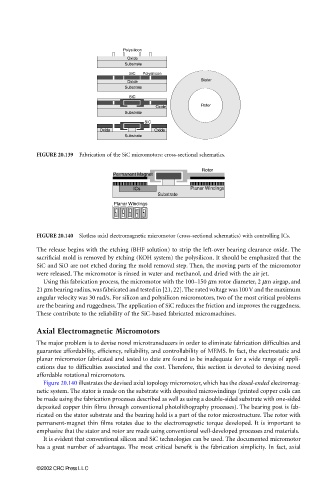Page 660 - The Mechatronics Handbook
P. 660
0066_Frame_C20.fm Page 130 Wednesday, January 9, 2002 1:48 PM
Polysilicon
Oxide
Substrate
SiC Polysilicon
Stator
Oxide
Substrate
SiC
Rotor
Oxide
Substrate
SiC
Oxide Oxide
Substrate
FIGURE 20.139 Fabrication of the SiC micromotors: cross-sectional schematics.
Rotor
Permanent Magnet
ICs Planar Windings
Substrate
Planar Windings
FIGURE 20.140 Slotless axial electromagnetic micromotor (cross-sectional schematics) with controlling ICs.
The release begins with the etching (BHF solution) to strip the left-over bearing clearance oxide. The
sacrificial mold is removed by etching (KOH system) the polysilicon. It should be emphasized that the
SiC and SiO are not etched during the mold removal step. Then, the moving parts of the micromotor
were released. The micromotor is rinsed in water and methanol, and dried with the air jet.
Using this fabrication process, the micromotor with the 100–150 µm rotor diameter, 2 µm airgap, and
21 µm bearing radius, was fabricated and tested in [21, 22]. The rated voltage was 100 V and the maximum
angular velocity was 30 rad/s. For silicon and polysilicon micromotors, two of the most critical problems
are the bearing and ruggedness. The application of SiC reduces the friction and improves the ruggedness.
These contribute to the reliability of the SiC-based fabricated micromachines.
Axial Electromagnetic Micromotors
The major problem is to devise novel microtransducers in order to eliminate fabrication difficulties and
guarantee affordability, efficiency, reliability, and controllability of MEMS. In fact, the electrostatic and
planar micromotor fabricated and tested to date are found to be inadequate for a wide range of appli-
cations due to difficulties associated and the cost. Therefore, this section is devoted to devising novel
affordable rotational micromotors.
Figure 20.140 illustrates the devised axial topology micromotor, which has the closed-ended electromag-
netic system. The stator is made on the substrate with deposited microwindings (printed copper coils can
be made using the fabrication processes described as well as using a double-sided substrate with one-sided
deposited copper thin films through conventional photolithography processes). The bearing post is fab-
ricated on the stator substrate and the bearing hold is a part of the rotor microstructure. The rotor with
permanent-magnet thin films rotates due to the electromagnetic torque developed. It is important to
emphasize that the stator and rotor are made using conventional well-developed processes and materials.
It is evident that conventional silicon and SiC technologies can be used. The documented micromotor
has a great number of advantages. The most critical benefit is the fabrication simplicity. In fact, axial
©2002 CRC Press LLC

